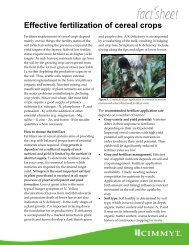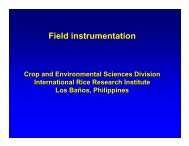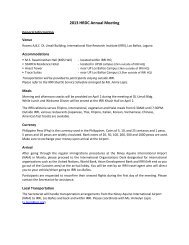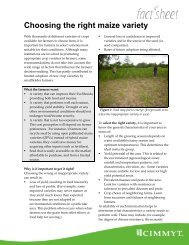Water management in irrigated rice - Rice Knowledge Bank ...
Water management in irrigated rice - Rice Knowledge Bank ...
Water management in irrigated rice - Rice Knowledge Bank ...
- No tags were found...
Create successful ePaper yourself
Turn your PDF publications into a flip-book with our unique Google optimized e-Paper software.
Flooded yield (t ha –1 )87A65432102001 2002 2003 2004 2005% Aerobic yield1009080706050403020100Cont<strong>in</strong>uousNewRestored2001 2002 2003 2004 2005YearFig. 3.9. Yield of aerobic <strong>rice</strong> variety Apo under floodedconditions (A) and relative yield of Apo under aerobicconditions (as % of the Apo yield under flooded conditions)(B). In B, the black columns <strong>in</strong>dicate cont<strong>in</strong>uous aerobicconditions, the darkly shaded column <strong>in</strong>dicates yield undernew aerobic conditions after conversion of flooded fields,and the lightly shaded column <strong>in</strong>dicates yield under restoredaerobic conditions after 1 year of fallow or flooded conditions(average is given). Data from Bouman et al (2006a).flooded <strong>rice</strong>-<strong>rice</strong> cropp<strong>in</strong>g (Roland Buresh, personalcommunication).There are <strong>in</strong>dications that soil-borne pestsand diseases such as nematodes, root aphids, andfungi occur more <strong>in</strong> nonflooded <strong>rice</strong> systems than<strong>in</strong> flooded <strong>rice</strong> systems (Sharma et al 2002, S<strong>in</strong>ghet al 2002, Ventura and Watanabe 1978, Venturaet al 1981). Current experience is that under fullyaerobic soil conditions, <strong>rice</strong> cannot be grown cont<strong>in</strong>uouslyon the same piece of land each year (ascan be successfully done with flooded <strong>rice</strong>) withouta yield decl<strong>in</strong>e (George et al 2002). Figure 3.9presents recent data from a cont<strong>in</strong>uous aerobic <strong>rice</strong>cropp<strong>in</strong>g experiment at IRRI (Bouman et al 2005,Peng et al 2006). S<strong>in</strong>ce 2001, aerobic <strong>rice</strong> varietyApo has been cont<strong>in</strong>uously grown under floodedand aerobic conditions <strong>in</strong> the same field. Floodedyields <strong>in</strong> the dry season are usually 6.5−7 t ha −1 ,except <strong>in</strong> 2001, when diseases depressed yields. InBYield (kg ha –1 )2,5002,0001,5001,0005000060120N (t ha –1 )160200Fig. 3.10. Yield of aerobic <strong>rice</strong> variety Apo under aerobic soilconditions at IRRI <strong>in</strong> 2004, at four levels of fertilizer N supply,and under three levels of water <strong>in</strong>put (black column = 1,147mm, darkly shaded column = 772 mm, and lightly shadedcolumn = 632 mm). Unpublished data, IRRI.2001, yield under aerobic conditions was 86% ofthat under flooded conditions, but this graduallydecl<strong>in</strong>ed until it was only 45% <strong>in</strong> 2005. In 2003,half of the flooded fields were converted to aerobicconditions, and aerobic yields returned to 85% ofthe flooded yields, as <strong>in</strong> the first year, 2001. In 2004,half of the cont<strong>in</strong>uous aerobic fields were left fallowor were flooded for the whole year, and returnedto aerobic conditions <strong>in</strong> 2005. This “restoration”attempt brought aerobic yields back to 65% offlooded yields, and was only partially successful.The mechanisms beh<strong>in</strong>d the gradual yield decl<strong>in</strong>eand the restoration effect are not yet understood,although high levels of the nematode Melodoigynegram<strong>in</strong>icola are found <strong>in</strong> the aerobic <strong>rice</strong> fields(up to 3,000 counts g −1 fresh root) compared withthe flooded fields (6−400 counts g −1 fresh root;unpublished data).In some field experiments and farmers’ fields,nearly complete yield failure has been observed <strong>in</strong>fields where aerobic <strong>rice</strong> was established the veryfirst year (Fig. 3.10). Usually, such fields had a lightsoil texture and a history of be<strong>in</strong>g partially croppedto upland crops or to <strong>rice</strong> under nonflooded conditionsbefore aerobic <strong>rice</strong> got established. Always,nematodes were found when yield failures wereobserved, sometimes aggravated by the presence ofroot aphids, fungi, and/or nutrient disorders. Croprotation is necessary under such conditions, andbreeders are try<strong>in</strong>g to develop aerobic <strong>rice</strong> varietieswith tolerance of these soil sicknesses.33





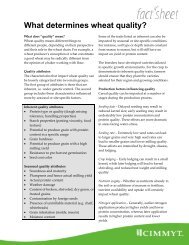

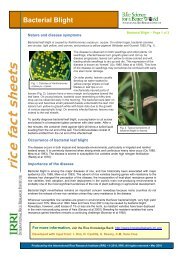

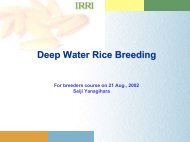
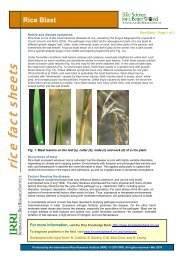
![International Standards' Organization â Rice Specification [ISO 7301]](https://img.yumpu.com/36696862/1/190x245/international-standards-organization-a-rice-specification-iso-7301.jpg?quality=85)

